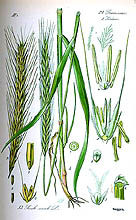| Home A B C D E F G H I J K L M N O P Q R S T U V W X Y Z |
|
Home |
Rye Nutrition Facts
Next time you make a sandwich, swap your wholewheat bread for rye. According to a Swedish study, people who ate a slice of rye felt fuller for longer. “Rye is higher in fiber, which may mean it’s digested slower,” says lead researcher Hanna Isaksson. Look for loaves that list rye as the first ingredient and pack in at least five grams of fiber per slice. Rye is a cereal grain that looks like wheat but is longer and more slender and varies in color from yellowish brown to grayish green. Foods made from whole rye are worth looking for, not only for their rich, hearty taste, but for their numerous health benefits. Eating foods high in insoluble fiber, such as rye, can help women avoid gallstones, shows a study published in the American Journal of Gastroenterology.
Studying the overall fiber intake and types of fiber consumed over a 16-year period by over 69,000 women in the Nurses’ Health Study, researchers found that those consuming the most fiber overall (both soluble and insoluble) had a 13 percent lower risk of developing gallstones compared to women consuming the fewest fiber-rich foods. Those eating the most foods rich in insoluble fiber gained even more protection against gallstones: a 17 percent lower risk compared to women eating the least. And the protection was dose-related; a 5-gram increase in insoluble fiber intake dropped risk dropped 10 percent. The FDA permits foods that contain at least 51 percent whole grains by weight (and are also low in fat, saturated fat, and cholesterol) to display a health claim stating consumption is linked to lower risk of heart disease and certain cancers. Now, research suggests regular consumption of whole grains also reduces risk of type 2 diabetes. Due to their high-fiber content, whole rye foods can help to prevent high blood sugar levels in diabetic patients, thereby helping with blood sugar control.
Rye and other whole grains are a rich source of magnesium, a mineral that acts as a co-factor for more than 300 enzymes, including enzymes involved in the body's use of glucose and insulin secretion — another reason why rye reduces the risk of type 2 diabetes. Rye is also good source of vitamin E, calcium, iron, thiamin, selenium, phosphorus, and potassium, and a very good source of manganese, which helps to protect us against viruses and other infections by strengthening our cell walls; manganese may also produce "killer" cells that destroy diseased or infected cells. In addition, manganese helps to strengthen bones, collagen and connective tissue such as ligaments, and helps to promote normal nerve function. Like most grains, rye is available throughout the year.
|
|
|
|
|
|
Glossary References Links Contact
|